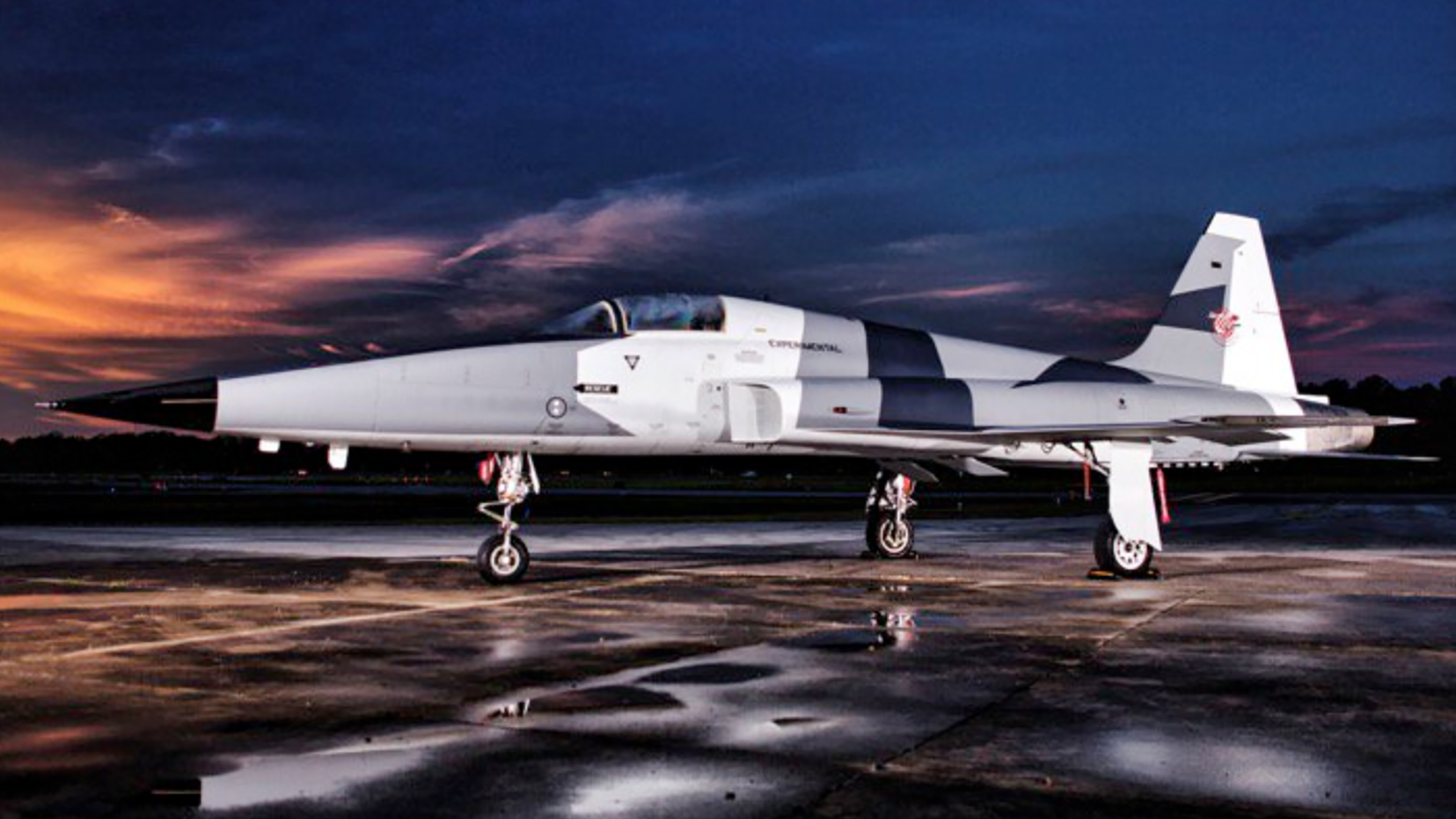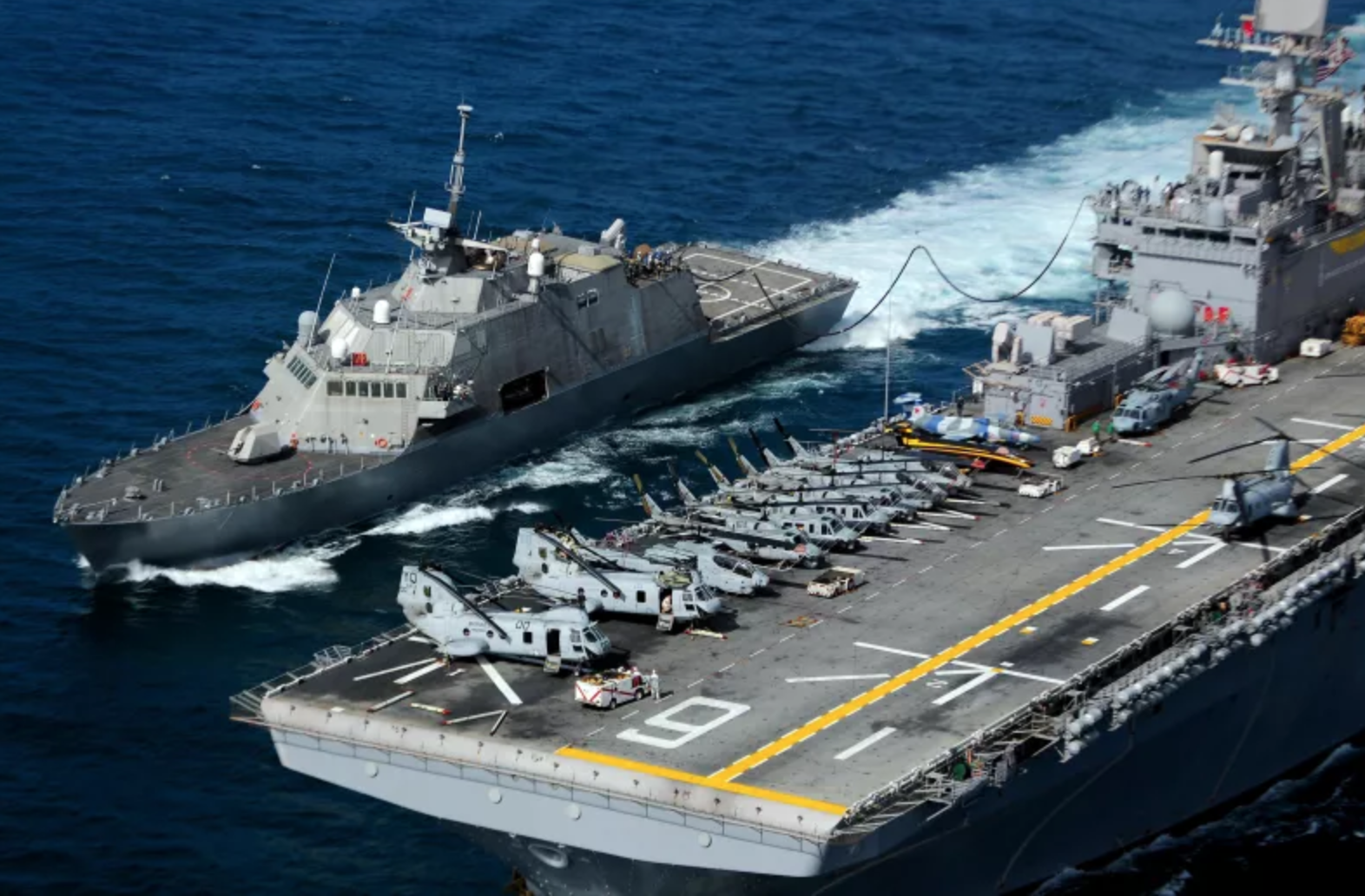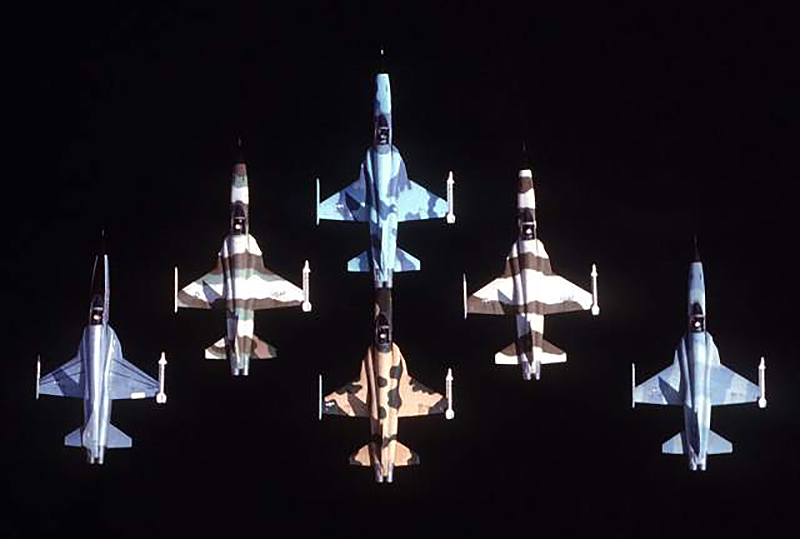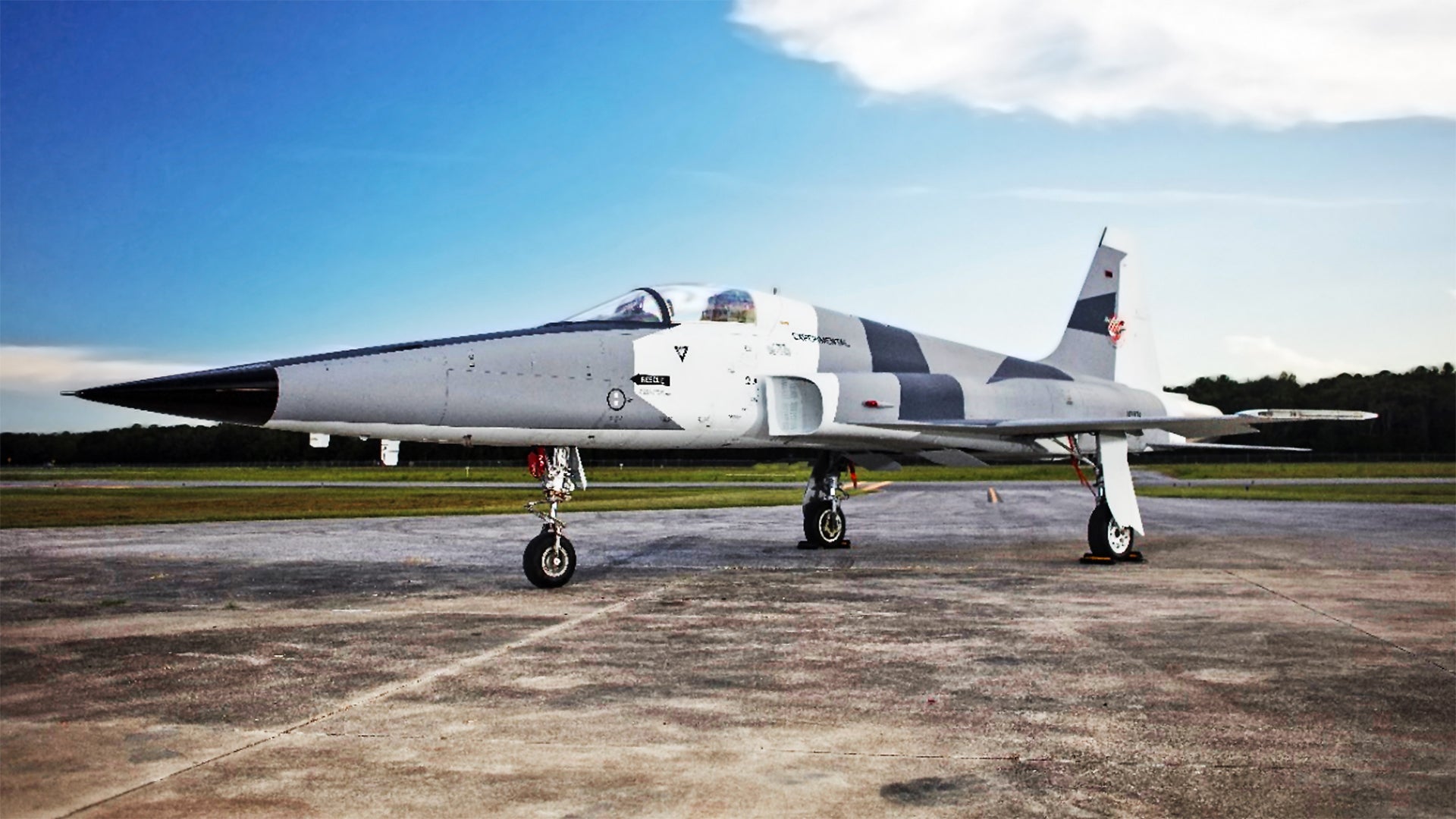Private red air contractor TacAir is the purchaser of the ex-Jordanian F-5Es that we wrote about being pulled off a 747-400F in Florida last February. The aircraft were going to be overhauled by the Northrop Grumman plant located in St. Augustine that also supports the Navy and Marine Corps’ F-5Ns, and has upgraded other air arms’ aging Tiger IIs with structural and avionics enhancements over the years. These aircraft were the only four delivered from Jordan to the U.S. via air, with the other 17 examples being shipped via ocean freighter to the facility. In all, 21 ex-Jordanian F-5E/F airframes were purchased as part of the deal.
These aircraft will drastically augment TacAir’s current F-5 fleet, which includes an F-5B and three CF-5D Freedom Fighters, the latter of which are license-built Canadian derivatives of Northrop’s first generation F-5. All four aircraft are two seat variants.
Aviation Week’s James Drew notes that about half the Jordanian order have been delivered to TacAir, either conveniently to their St. Augustine satellite location or to their headquarters at Stead Field in Reno, Nevada. Half will wear the black, white, and gray “splinter” camouflage with the other half wearing a desert brown motif.
As we have mentioned in the past, the F-5 may be a dated airframe, but it is a highly reliable and efficient one. With new sensor options that are available off the shelf, the type can offer 4th generation fighter-like capabilities at a fraction of the cost. TacAir writes in their platform description the following about their unique F-5s:
“While the baseline F-5 flown by USN/USMC is widely considered a 3en Generation aircraft, TacAir’s existing and planned upgrades economically evolve this aircraft into an advanced tactical aircraft with sensor/system capabilities on par with current DoD 4th Generation fighter aircraft. TacAir F-5s are upgraded with HUD/HOTAS [Heads Up Display/Hands On Throttle And Stick], open architecture mission computers and tailored Operational Flight Programs that enable integration of advanced radar systems, IRST [Infrared Search and Track], EA [Electronic Attack], RWR [Radar Warning Receiver], datalinks, and HOBS [High Off Boresight] simulated weapons employment.”
The main upgrade that would make these aircraft able to perform 4th generation fighter threat replication would be the inclusion of a modern radar system. TacAir’s website associates their aircraft with both the Grifo-200 and APG-66 pulse doppler radars, although it is unclear if these sets have actually replaced the AN/APG-153/159 radars originally installed in most F-5s or if new radar systems like the ones mentioned will be integrated into their F-5 fleet if the company wins a major adversary support contract.

It’s also worth noting that both radar sets are currently flying with TacAir’s competitor, Draken International—the Grifo on their L159s and the APG-66 on their A-4Ks. Other radar options for the F-5 exist as well, such as Israel’s modular and highly capable Elta EL/M-2032 radar set.
TacAir has been around for quite some time. The company has been associated with many platforms over the years, but not in a large operational format. These have included L-29 “Vipers,” Super Tucanos, and even Su-27s which are prominently featured in their logo. They were the outfit that was originally tied to the procurement of two ex-Ukrainian Su-27s that were refurbished by Pride Aircraft before they were put up for sale only to disappear into the shadows of the classified world.

The company’s website notes that they have current experience in operating “customer owned” Su-27s as well as F-16s. They also provide close air support/Joint Terminal Attack Controller (JTAC) training. Above all else, the company is known for its consulting work on various projects and operations related to air combat, munitions, and adversary support duties. The company describes their deep bench of highly experienced aircrew and subject matter experts as such:
“The TacAir team brings the strongest cadre of proven leaders and aviators paired with a modern, sustainable, safe and upgradeable fighter platform. This diverse staff consists of former Weapons School Instructors, Graduates, Adversaries, and Test Pilots including: a Former U.S. Air Force Chief of Staff who is the Chairman of the Board, 4 former Air Wing/Group Commanders, 12 former US Air Force/US Marine Corps & US Navy Squadron Commanders, a former Operational Test Squadron Commander, 4 Test Pilots, 3 former Weapons School Commanders, 52 Weapons School Graduates, 17 former Weapons School Instructors, and 2 Astronauts.”
With the Navy and the USAF having large adversary support contracts up for grabs, and more to be had internationally, TacAir’s growing F-5 fleet strategy is an intriguing one. It represents a known and cost effective commodity for both the USAF and especially the USN and Marines. The type has served continuously as an adversary for over 40 years. For a good portion of that time it filled out the ranks of various USAF aggressor squadrons around the globe, and maybe most notably, it was a staple of the Navy’s Fighter Weapons School, better known as Topgun. It also starred in the movie by the same name as the “MiG-28.” You can read all about how the F-5 was employed by Topgun instructors as an adversary aircraft in this past War Zone feature.

The F-5 has stood the test of time in adversary service, with three squadrons of the jets—two US Navy and one Marine—still going strong. And the USMC in particular is so happy with the type that they want more of them, which is a good sign for TacAir.
The jet has other attributes going for it beyond being proven and reliable. It’s capable of supersonic speeds, is hard to spot, and agile in its own right. Overall it remains a credible adversary when flown by a highly experienced pilot. When paired with an upgraded pulse doppler radar and cockpit displays it could prove to be a very efficient platform that is capable of meeting the 4th generation adversary threshold requirements but at a far lower operating cost than more complex alternatives. And once again, its ability to travel at supersonic speeds gives it an edge over the handful of subsonic radar equipped tactical aircraft now flying in the contractor air services arena.
Certain synergies could also potentially be had with the Navy and Marine Corps’ existing fleet of roughly 45 F-5N and F-5F aggressors, especially in terms of sustainment, upgrades, and tactics development. Also, training TacAir F-5 pilots would likely be easier and far less expensive than doing so with a foreign type as Navy and Naval Reserve pilots already flying the F-5 or who had done so previously could port directly over to TacAir ranks. Even USAF pilots have time in the T-38 Talon, which was the progenitor of the F-5 and shares many similarities with it.

On the other hand, if the services are willing to spend more on an operator that brings a true 4th generation aircraft to the table, such as via the F-16, TacAir may have a tough time competing with their F-5s. But this seems unlikely considering the whole idea of outsourcing some of a service’s adversary support needs is to increase capacity while saving money in the process. Additionally, one service’s needs aren’t the same as another’s, or that of an international air arm who may need a one-size-fits-all higher-end adversary support source, or just cheap supersonic target replication to challenge their 5th generation F-35s.
With all this in mind, TacAir seems well suited to fulfill the lower-end supersonic 4th generation adversary support niche, and even if they aren’t selected for a contract, they could easily bolster the company that is with more capacity or be added on in additional future contracts. As I have been stating for many years—before many people recognized the looming contractor adversary air support industry boom—as F-35 comes online, the Pentagon and other air arms that operate it will have an insatiable appetite for commercial adversary support.
This is due to the high operating costs of stealth fighters, the need to prolong their airframe life, the waste associated in using them to replicate rudimentary adversary capabilities in mock combat, and due to the fact that they will require greater numbers of adversaries to challenge their pilots. This means more targets in the arena at one time—a perfect job for the spritely and efficient F-5—especially one equipped with a decent radar and a datalink.
UPDATE: We talked to TacAir’s Mick Guthals about their F-5s and their business plans related them and he confirmed pretty much everything in this article, but added a few additional bits of information.
Beyond being a known and economical commodity with great manufacturer support, the F-5’s ease of upgrade is a major selling point for the jet. As we discussed earlier, many off-the-shelf upgrades exist for the F-5E/F and that means integration costs would be minimal. A foreign fighter like the Mirage F-1, which has deeply integrated avionics, would likely require more investment to reconfigure the aircraft with new technologies, especially ones not available from the OEM but from a third party supplier.
As for if these aircraft will provide basic fighter maneuvers (BFM or dogfighting basically) training, Guthals noted that the services really haven’t fully developed the role of the commercial adversary. As I have reported in the past, a big misconception is that commercial adversary support providers basically dogfight with fleet pilots. That isn’t the case. By most accounts even aircraft armed with AIM-9M Sidewinder captive training rounds—a new development in this decade—are usually limited to 180 degree “turning” fight before having to “knock it off.” In other words, the hard turning “fur ball” dogfights are left for organic adversary support. But this could change as contractors become more deeply embedded into the Pentagon’s air combat training apparatus.
The general target for contractor adversary providers is to provide an adversary aircraft at 60% of the cost of the fleet alternative. Basically, if intercept practice is needed by an F-15 squadron, using the contracted F-5 should cost 40% less than it would cost for the USAF to put up another F-15 for that role—which is common practice today and hugely wasteful.
Using contractors will also allow for a more tailored and cost effective use of airframes to support adversary training. For instance, a USAF F-15 may get another F-15 as a sparring partner for BFM training, but the next day a contractor F-5 can be used instead of a fleet F-15 for radar intercept training. Additionally, these assets can be mixed and matched to provide a better training syllabus without busting the budget. Even different levels of contractor adversary aircraft, such as F-16 and F-5, can be used for different training objectives.
Guthals also said that exactly what upgrades TacAir’s F-5s would receive, such as new radars and helmet mounted displays, will be based on what the customer wants. This will also be factored into the cost of supplying the aircraft for training. So at this point, the jet’s are freshened up, but not loaded with new sensors and such because the company wants to tailor the aircraft’s configuration to the customer’s needs. This makes sense as these types of upgrades are not cheap for air arms, yet alone private entities.
We will keep you up to date as TacAir’s ambitious business plans unfold.
Contact the author: Tyler@thedrive.com
